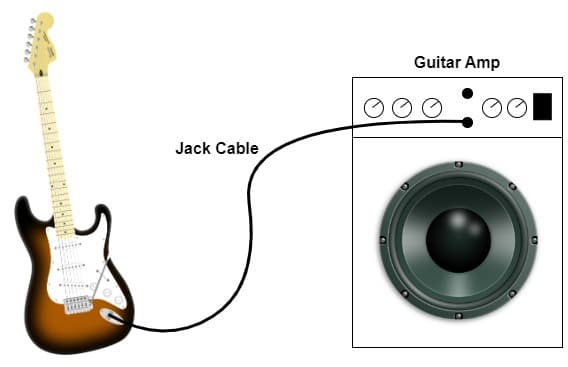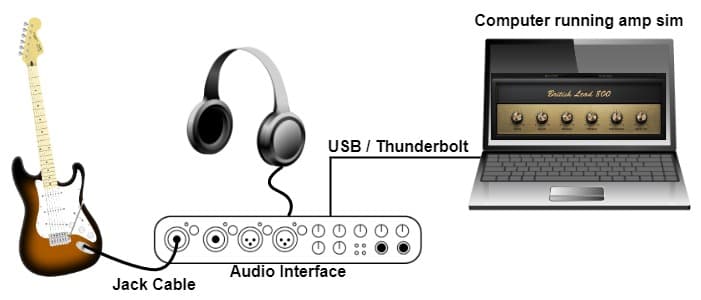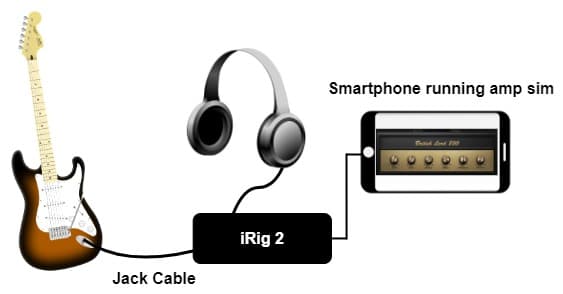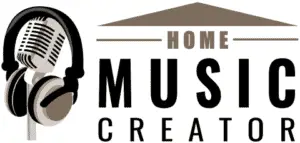DISCLOSURE: This post contains affiliate links. If you buy through these links, I may earn a small commission.
The traditional way to get sound out of an electric guitar for almost a century has been to plug it into a dedicated guitar amplifier. Most of the time when I play at home these days, I don’t bother. With the technology available today, there is no need to plug your electric guitar into an amplifier if you don’t want to.
An electric guitar can be played without an amp by plugging it into a computer, smartphone, or tablet running guitar amp sim software. Alternatively, use dedicated headphone amps or the headphone out on a multi-effects unit. Electric guitars with built-in amps are also available.
In this article, I detail several different methods of playing an electric guitar without an amp. Each of these methods is particularly suited to a different application and exactly what you are trying to achieve. I go on to discuss the various reasons you may have for playing electric guitar without an amp, and why for some guitar players using an amp is still the best choice.
If you are interested in checking out the best recording gear such as audio interfaces, studio monitor speakers, microphones, etc., you can find them at Amazon by clicking here.

How to use a traditional guitar and amp setup
Just in case you are a beginner guitar player looking for information on how to use your electric guitar, here is a quick guide to how electric guitars have always traditionally been used.
An electric guitar traditionally connects to a guitar amplifier. A standard ¼” jack cable is used to connect the jack output of the guitar to the jack input of the amplifier. The volume and tone can be adjusted using the amp’s controls, along with the volume and tone controls on the guitar.

There are actually several types of guitar amplifier, which can be quite confusing for beginners. That’s why I wrote an article all about guitar amp heads, combos and cabs, which clearly explains the different types of guitar amp equipment. It’s essential reading if you’re new to all this.
Methods for playing electric guitar without an amp
There are several methods you can use to play an electric guitar without a real physical amplifier. Here is a summary of the methods, with their advantages and drawbacks…
| No amp method | Advantages | Disadvantages |
|---|---|---|
| Play acoustically | – Cheap – No extra equipment required | – Doesn’t sound like an electric guitar is supposed to – May be too quiet |
| Amp sim running on a computer | – Cheap if you already have a computer & audio interface – Excellent free amp sims available – Many sounds available (amp and effects models) – Great sound | – Need a computer – Need an audio interface – Computers crash! – Potential latency issues – Lack of real amp “feel” |
| Amp sim running on a phone | – Cheap if you already have a smartphone – Convenience | – Ties up your smartphone – Need an interface – Latency issues (potentially worse than with a computer) – Same lack of real amp “feel” |
| Guitar headphone amps | – Cheap option – No extra equipment required, just the headphone amp – Small, convenient | – Sound quality is not great – Just one or a few sounds available |
| Boss Waza-Air headphones | – Excellent sound quality – Huge variety of sounds – Phone app to configure your sound | – Very expensive – Need a smartphone for the app |
| Multi-effects unit headphone socket | – Cheap option if you already have multi-effects unit – No extra equipment required | – Can be tricky/fiddly to operate – Cost of the multi-effects unit – Sound quality variable |
| Electric guitar with built-in amp | – Convenience – No extra equipment required, just the guitar itself – Great travel guitar option | – Sound quality ok at best – Cost |
One potential other method not covered in this article is using a Bluetooth speaker. I have a whole article dedicated to connecting electric guitars to Bluetooth speakers. Check it out to discover the different ways to do this, the problems you may encounter and alternative methods for wireless guitar connections.
Now let’s get into the details of the different methods from the table…
Play your electric guitar acoustically
Now you may be thinking “Are you kidding me? I came here for some super ninja tips on playing electric guitar without an amp, and you’re just telling me to play the electric guitar acoustically? Are you serious?!”
Hear me out! So when we say play it acoustically, we just mean pick up your guitar and start playing it, without plugging it into anything. Unsurprisingly, this is the cheapest option.
Playing an electric guitar not plugged into anything works absolutely fine. It’s quite quiet, but as long as there isn’t a lot of loud background noise you should be able to hear it without issue. It is often said that if an electric guitar sounds good acoustically, it will sound good amplified. So if you’re buying a guitar in a store, it’s always worth playing it unplugged and listening to how it sounds.
The fairly obvious drawback with this method is that it won’t sound how an electric guitar is supposed to sound. They were designed to be amplified and to be run through effects such as overdrive, reverb, delay, etc. You get none of this when playing unplugged. You also can’t use feedback, which has been a big part of rock ‘n’ roll guitar since the 1950s.
Don’t dismiss playing an electric guitar acoustically though. When I got my first electric guitar, I played for months without an amplifier and learned to play many songs that way. It’s also the cheapest and simplest method if you need to play quietly, e.g. late at night or if you have young children trying to sleep.
Amp sim running on a computer
Guitar amplifier simulator software or “amp sims” can be run on a computer, and essentially do the same job as a guitar amp. Plug your guitar into an audio interface connected to the computer, plug some headphones or speakers into the audio interface, and you basically have a virtual guitar amp that does the same job as the real thing.

If you are interested in running amp sims on a computer, I highly recommend my “How to use your PC as a guitar amp” article. You will learn exactly how to set up this type of system, what equipment you will need and how to avoid some of the common pitfalls when using amp sims.
Amp sims should perhaps more accurately be called rig sims, as they typically do not just simulate the amplifier. They often also simulate a multitude of effects, speaker cabinets, microphone placements, room ambience, etc.
This setup gives you the great advantage that your electric guitar will sound like it was supposed to i.e. amplified and with the ability to add all sorts of effects. If you already have a computer and/or audio interface, it is also cheaper than a real guitar amp. There are many free amp sims available today, as well as many paid ones ranging from a few 10s of dollars up to many 100s.
Typical amp sims provide several different amp models, typically modeled on real-world guitar amps. They also often have many different effects you can add in to your signal chain. This is one of the major advantages of amp sims – their versatility and configurability. It would cost you many thousands of dollars to buy the hardware equivalents of everything you get in an amp sim, often for free.
If you do go down the amp sim on computer route, you will definitely need an audio interface. I highly recommend the Focusrite Scarlett audio interfaces, which I have been using for years for playing guitars through amp sims and recording with great results. You can pick up the Focusrite Scarlett Solo (affiliate link) from Amazon for a very reasonable price.
This amp sim setup does have some disadvantages though. Obviously, you have to have a computer to run the amp sim software on. While computers’ reliability has improved massively over the last few years, they do have a tendency to crash occasionally. Not what you want in the middle of a live performance!
You can encounter latency issues when using amp sims. This is the time it takes between playing a note on your guitar and hearing that note come out of the amp sim. If this is a few milliseconds then you won’t even notice it. But once you get into 10s of milliseconds, a noticeable lag will be present.
Latency issues usually occur when your computer hardware isn’t good enough, or if you have an audio configuration issue. Fortunately, almost all modern hardware is capable of giving low enough latency. And the use of dedicated high-quality audio drivers usually fixes the configuration. To learn more about latency and how to improve it, check out my “Reducing Guitar Amp Sim Latency” article.
Some guitar players say that amp sims don’t sound as good as a real amp. My opinion is that when amp sims first appeared on the scene a couple of decades ago, that was probably true. These days the technology has improved massively and I feel they are a viable replacement for real amps, in many cases sounding just as good as the real thing.
What you don’t get with amp sims is the exact same feel as playing through a real tube amp. Again, this has got better with time. And who knows, maybe in a few years the technology will be at a point where you won’t be able to tell that you’re not playing through a real amp.
Amp sim running on a smartphone
You can also run amp sim software on your modern smartphone (Android or iPhone), effectively turning your phone into a guitar amp.

Much like running amp sims on a computer, you will need an audio interface to be able to get your guitar signal into your phone. Standard audio interfaces you would use with a computer should work, as long as you have the right cable to connect it to your phone (usually USB-C or micro-USB).
There are dedicated portable interfaces available that are specifically designed to connect your guitar to your smartphone. The most popular of these is probably the iRig 2 from IK Multimedia, which is very highly thought of. You can pick up an IK Multimedia iRig 2 (affiliate link) from Amazon for a great price.
The advantages and disadvantages of using amp sims on a smartphone are the same as those for using amp sims on a computer.
Using guitar headphone amps
Guitar headphone amps are small boxes that typically have a ¼” jack plug coming out of them. They are designed to plug directly into your electric guitar’s jack socket. They also have a headphone socket for you to plug your headphones into.
Headphone amps have amplifier circuitry built into them, and kick out just enough output to drive a pair of headphones. They are a great cheap way of hearing your electric guitar amplified, starting from about $30.
For a great well thought of headphone amp, the Vox amPlug G2 AC30 (Amazon affiliate link) comes highly recommended.
My personal preference would still be to use amp sims on a computer. Headphone amps do not give you the versatility and number of options that amp sims provide, with just one or a few sounds available. The sound quality is also not as good as amp sims.
However, if you are looking for a cheap way of hearing your electric guitar amplified and aren’t too bothered about having lots of sound configuration options available, they can be a good choice.
Boss Waza-Air Headphones
I’m going to quickly mention another option in this headphone amp section – The Bozz Waza-Air headphones. These are a pair of headphones with the amplification circuitry built into the headphones themselves.
They come with a wireless transmitter that plugins into your guitar’s jack socket, and transmits the guitar signal to the headphones. You use the Boss Tone Studio app on your phone to configure the sound, selecting and configuring the amp and effects models you want.
I like to think of these headphones as a combination of amp sim and headphone amp technology. The big advantage of these over a standard headphone amp is the sound quality – they sound amazing. There are many reviews on YouTube singing their praises – check out this one for example…
The big disadvantage of the Boss Waza-Air headphones is the price. They are very expensive compared to a headphone amp, or even to a lot of paid amp sims. You’re basically looking at around $350 for a pair. But I guess you get what you pay for, and only you can decide if the sound quality and available sounds are worth it.
Use a multi-effects unit’s headphone socket
Multi-effects units are often used between an electric guitar and a guitar amp to provide lots of effects you can use to alter the sound. Typically the guitar is plugged into the effects unit’s input, and the output of the effects unit is plugged into the amp’s input.
But you could also use one without the guitar amplifier. If your multi-effects unit has a headphone socket, you could plug your headphones into it and hear your guitar that way.
If you already have a multi-effects unit, this is a very cheap way of playing without a guitar amp. If not, obviously the cost of the unit is a drawback. Instead, if you already have a computer and audio interface you could add a free amp sim and you effectively have a free virtual amplifier.
Electric guitars with built-in amps
Believe it or not, there are some guitars that have amplifiers built-in!
The Pignose PGG series is a great example. It has an amp built in to the body of the guitar, with its speaker under the strings just above the pickup. It also has a jack socket, so you can plug the guitar into a standard amp like normal.
I borrowed one of these Pignose guitars from a friend when I went on vacation once. I wanted a small guitar suitable for travelling, and my friend kindly lent me his. It was ideal for that application. OK, the built-in amp is not going to win any awards for sound quality or volume. But it was a perfect travel guitar for noodling around with on vacation.
I can recommend the Pignose GCC guitars if you are looking for an instrument that you can hear amplified without any extra equipment at all. You can pick up the Pignose PGG-200 (affiliate link) for a very reasonable price at Amazon.
Reasons to play electric guitar without an amplifier
Why would you want to do away with decades of tradition and play your electric guitar without an amp anyway? Let’s look at a few reasons you might have…
To keep the volume down
Guitar amps can be loud! Maybe you have young children sleeping, or you want to practice late at night in a shared household. Or perhaps you live in an apartment block with thin walls. Playing through a guitar amp at volume may just not be feasible for you.
There are guitar amps that will sound good at low volumes. But I would argue that there are better alternatives available for playing quietly.
Cost
If you’ve spent any time searching online music stores for guitar-related equipment, you’ll know how expensive guitar amps can be. They range from around $50 up to multiple $1000s. If you need a guitar amp for playing shows, realistically you’ll need to spend a few hundred dollars at the very minimum.
If you already have a laptop, then you can load free guitar amplifier simulator software onto it – so-called “amp sims“. You’ll also need an audio interface, which you can pick up for around $70. Add a pair of headphones or speakers and you have a fully functioning virtual guitar amp.
This setup also allows you to replace your amp with an audio interface and laptop combination, and plug the audio interface output into a PA system. You now have a full concert-ready guitar amplification setup instead of a real guitar amp, potentially saving you $100s or even $1000s.
Space
Guitar amps can be bulky, especially tube amps. If you have a separate amp head and speaker cabinet the speaker cabinets can be huge, especially if they have 4 or more speakers in them.
If you live in a small apartment or 1-bedroom bedsit or similar arrangement, a laptop running an amp sim into a pair of headphones will take up very little space compared to a bulky real amplifier.
Real amps are unnecessary
In these modern times, real guitar amps are just not a necessity any more.
The technology available to us with guitar amp sim software gives us options to do away with real physical guitar amps altogether. Even for live performances, some professional guitar players have ditched their real amps and are using laptops running amp sims through the band PA system.
Why guitar players still choose real amps
Even with all the alternatives available to us today, many, many guitar players still choose to play through real amps. Let’s take a look at a few of the reasons why…
Some guitar players are traditionalists and insist that nothing sounds as good as a real physical guitar amplifier, especially tube amps. You’ll have to make your own call on this one. I think the technology has evolved to the point now where some of the alternatives are very, very close to the real thing.
There is somewhat of an obsession with tubes in the guitar-playing community. Some believe that you will never be able to replicate the warmth, response, and sound of tubes in a guitar amp however good the technology gets.
Guitar amps are relatively simple devices, unlike computers which are fiendishly complicated! Your guitar amp is unlikely to crash on you in the middle of a guitar solo in front of a paying audience. Another plus point for the good old guitar amp there.
Performing guitar players often like complete control over their sound. For them, having a real amp behind them that they can tweak and control is essential. With an amp sim on a laptop going through a PA, the sound engineer has full control of the sound, not the guitar player.
Finally, there is the belief that real amps offer a better platform for pedals than any of the alternatives. This may or may not be true, but amp sims often offer many effects of their own built-in, eliminating the need for real physical pedals in many cases.
Here is some of my favorite home studio gear…
Thanks for reading this article. I hope you found it helpful in your home music-making activities. Here are a few of the tools that I personally use in my home studio. These are affiliate links, so if you decide to use any of them I’ll earn a small commission.
Audio interface: My personal choice for audio interfaces are the Focusrite Scarlett series. I have been using these for years, and they have always given me great-sounding recordings. For a very reasonable price from Amazon you can buy the excellent Focusrite Scarlett 4i4, or if you don’t need MIDI capability the Focusrite Solo is a great choice.
Amp sim: Guitar amplifier simulator software has come on leaps and bounds in recent years, such that I record all my electric guitar parts using amp sims these days. One of the very best is the incredible Amplitube from IK Multimedia, which I have used on many of my songs.
Headphones for recording: My favorite headphones for recording are the Sony MDR-7506s, which I use for monitoring during all my recording sessions. They can also be found in many pro recording studios. Get the Sony MDR-7506 headphones from Amazon here.
General-purpose microphone: You can’t go wrong with a good ol’ Shure SM-57, one of the most versatile and ubiquitous microphones around. I’ve been using one in my home studio for as long as I can remember. Amazon offers the Shure SM-57 for a very competitive price.
To see all of my most up-to-date recommendations, check out this resource I made for you!


